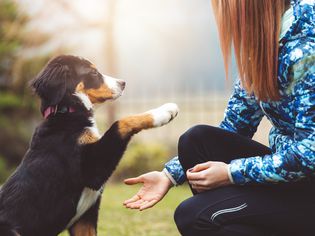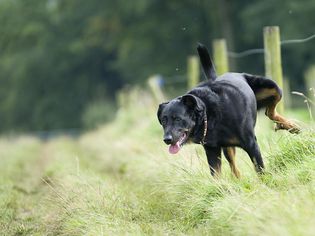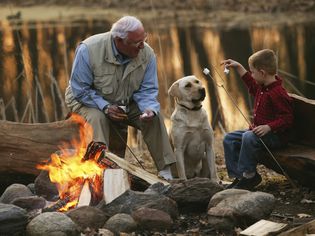There are many reasons why a dog may not instinctively engage in play with its human owners. For example, a dog kept in a kennel for breeding may have little positive interaction or experience with humans. A rescue dog may have been injured by its owner, or a puppy may simply be shy. If your dog or puppy is anxious or unwilling to engage with you, you can earn its trust through a slow, gentle process of socialization. Once your pet feels comfortable with you, it can learn to play and have fun.
Importance of Play
While some dog owners might not care if their dog is playful, there are a number of benefits involved in dog and puppy play:
- Playing offers dogs mental stimulation and a way to burn off energy.
- Playing is a great way to build a bond between you and your dog.
- Playing is a great way to reward your dog for learning new skills.
- Playing is fun! Just like with people, playing and doing activities they enjoy increase a dog's quality of life.
Patience is your most important tool. It can take time for a dog to start to trust its owners and even more time for it to learn appropriate ways to interact. Remember, though, that your goal is not to encourage your dog to do whatever it wants in whatever way suits it; rather, you are teaching it to interact with you following the rules and expectations that you'll want to set up.
So it's important to have a clear idea about boundaries and types of play that are acceptable to you. Be sure everyone working with your dog understands your goals, rules, and expectations. For example, your housemate may think it's cute when your dog growls while holding a toy in its mouth while you have set a rule that growling is unacceptable. Naturally, different sets of rules and different types of play will be confusing to your new pet.
Watch Now: How to Train Your Dog to Fetch
Start Slowly
There are several reasons a dog may not have learned to play. One common reason is a lack of early socialization. Some dogs don't play simply because no one has ever engaged in a game with them. Another reason is that their instincts may drive them to do other things. For instance, a border collie may have the drive to herd your children together in the yard rather than engage in a game of fetch.
No matter why your dog isn't playing, you should begin by slowly introducing it to toys and games. Start by leaving the toys around to sniff and get used to, rather than immediately trying to engage in an all-out game of tug-of-war. An improperly socialized dog may be scared if you move too fast, and a dog whose instincts are pushing it to do something else will just be confused.
Reward Interest
Start off with soft praise or a treat for any interest your dog shows in toys. You can even hide a treat or spread a little peanut butter on a tug toy or a ball. Your dog will quickly learn that toys mean good things happen.
Get Involved
Once your dog is comfortable with the toys, it's time to start interacting with it. Again, start slow. Sit close to your dog and roll a ball toward it or shake a tug toy a little. If it shows interest, give it a treat and praise. It may take some time, but the more you engage your dog in play, the sooner it will learn what's expected. Before you know it, your dog will be playing as if it's done it all its life.
Teach the Rules
Sometimes teaching a dog to play involves more than simply slowly introducing it to the idea. Games like fetch, for instance, have more than one part. It might be easy to teach your dog to run and pick up a ball you throw, but it'll have to know "come" and "drop it" in order for the game to continue smoothly without turning into a game of chase. If your dog is having trouble playing, make sure it knows the basic commands involved in playing the game.
Choose Games According to the Dog's Interests
Not every dog is going to like every kind of game. Try to choose games that best suit your dog's personality. A retriever is likely to enjoy a game of fetch. A terrier might really get into a game of tug-of-war. Herding dogs, such as border collies and Australian shepherds, tend to do well at agility and Frisbee. By matching the games you choose to suit the things your dog was bred to do (retrieving or herding, for example), it'll be easier to teach your dog to play, and a lot more fun for your dog.
Watch Now: How to Play Tug of War With Your Dog
Problems and Proofing Behaviors
Proofing is the process by which you ensure that your dog can keep up with new behaviors in a variety of settings and situations. It's not easy for a dog to play properly when it's in a new, exciting setting or playing with unfamiliar people or animals.
To proof your dog's new play skills, you'll want to place it in a variety of situations to see how well it retains its training.
- Take your dog to the dog park and see if it can continue to attend and follow your rules of play when other dogs are in the area.
- Have other people play with your dog, asking them to do the same things but using a different tone or set of toys.
- Watch to see how your dog does when given commands by a young child who may not have the same authoritative tone that you do.
If you discover that your dog hasn't really internalized the rules of play, you may need to go back to earlier steps in the process.
- Be sure your dog is truly comfortable in your home and seems to trust you and anyone else who interacts with it regularly.
- Reteach the commands you'll be using, such as "drop it," "come," and "fetch."
- Take time to expose your dog to the various settings and people it's likely to encounter on a regular basis. If necessary, reteach the skills with those people and settings.
For this type of training, patience is key; if you move too quickly, you may lose your dog's trust.










Comments on " How to Train Your Dog to Play" :